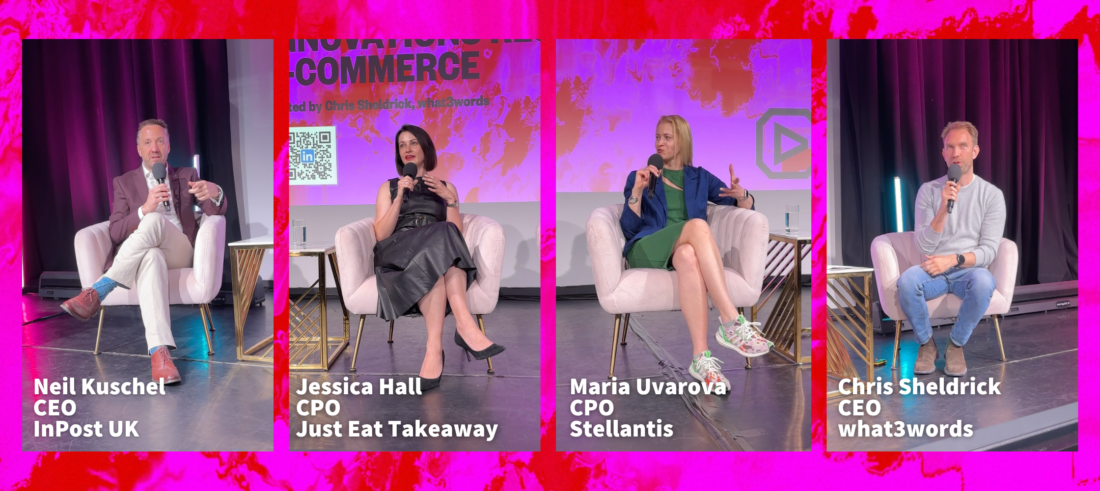
Our SXSW panel wrap-up: Putting the Last Mile First
“What the consumer is driving is convenience and flexibility that fits into their own life. And that requires the traditional models of everything to change.” – Neil Kusche, CEO at InPost UK. Industry leaders from InPost, Just Eat Takeaway.com, Stellantis, and what3words took to the stage at SXSW London to discuss the latest trends in consumer behaviour – and how these trends are reshaping the last mile.
The discussion ranged from the new definition of convenience and the innovations it inspires, to exploring how a simple solution exists that ensures imprecise addressing isn’t a barrier to unlocking the future of delivery.

Convenience and choice
Customers today demand more than just speed – they expect services that enhance their lives. Jessica Hall, CPO at Just Eat Takeaway.com , captured the new mindset perfectly:
“In the old days, status was about cars and watches. But today, status is about experiences…these services that give people control, it’s just one less job on your list and more time for doing the things that you really want to do.” The expectation of convenience “is growing and growing fast”, especially post-pandemic and in younger generations. The demand isn’t for laziness, but for a life lived more fully. As Jess put it, it’s about “convenience unlocking brilliant experiences…in life.”
Ultimately, the goal isn’t to predict every need but to provide choice. As Neil Kuschel, CEO at InPost UK , explained, while you might expect customers to want a delivery locker as close as possible, some InPost users proactively choose one further away because it contributes to their daily step goals.
This explains why out-of-home delivery is rapidly accelerating, with major retailers like ASOS, Debenhams, and boohoo now integrating flexible, out-of-home delivery options into checkout. As Neil put it, the key is to “give the power to the consumer to give them control” , letting them choose options that fit their lives, however they choose to live them.
The demands shaping last mile innovations
“We can really reuse a lot of cutting-edge innovation that we first tested with private vehicles and then deploy it into our commercial vehicles where this can actually define your profitability.” – Maria Uvarova, CPO at Stellantis
To cater to customers’ evolving expectations, Jessica Hall said it comes down to “obsessing about where customers are going to be and what they’re going to want.” The shift to electric vehicles is a perfect example, where Just Eat identified the hour-long charging window as a new opportunity for delivery – whether that’s food for the journey, or groceries so there’s one less stop to make.
This demand for seamless deliveries is being met with brilliant innovation on the automotive side. Vehicles are evolving to help couriers keep pace. According to Maria Uvarova, “cars become software powerhouses on wheels…even though the average lifecycle of a vehicle is still about 10 years, your infotainment system is actually constantly evolving.” This opens the door for an ever-improving in-car app store experience, creating a new ecosystem of services. Stellantis, for example, is developing tools like ‘MyTasks’, an app that allows commercial drivers to receive live updates and changes to their routes directly on their vehicle’s screen.
This forward-thinking is pushing the limits of delivery itself. At Just Eat, experiments with ground-based robotics and autonomous drones are redefining what’s possible. As Jessica Hall explained, these channels are about more than just takeaways; they’re digitising the high street and delivering everything from groceries to critical medical supplies.
This leap into automation, however, raises the stakes: a human courier can call if they’re lost, a drone cannot. As the delivery experience develops, and customer expectations keep rising, the margin for error shrinks correspondingly.
Extra precision, extra convenience
This evolution towards a fully flexible, on-demand world means that precision is more important than ever. However, delivery accuracy is a challenge when addresses aren’t built to be precise enough to point to a specific entrance. They could be duplicated or they might not exist in mapping systems yet. Our research indicates that this is a widespread problem in the UK:

By dividing the world into 3 metre squares and giving each square a unique address made of 3 words, what3words has made it easy to talk about any precise location – whether it’s a specific building entrance or a locker outside a busy station. For example, ///filled.count.soap is the address for our HQ in London. It’s the enabling layer of accuracy that ensures incredible innovations are delivered with incredible precision.
As businesses race to adapt, the panel’s message was unanimous: the customer is in control. Neil Kuschel left the audience with a powerful final thought that every business should consider:
“If you are not thinking about how to make your consumer’s lives easier, you will lose them to somebody who is.”
In the new age of convenience, being precise isn’t just a detail, it’s how you prove you’re helpful. And being truly helpful is the key to success.
Let’s talk about how what3words can power your innovations.
